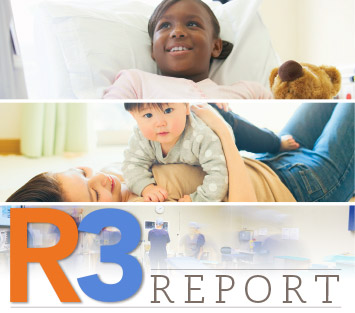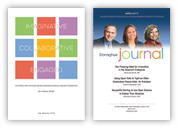Practically Speaking
Summer 2017
R3 Report

Donaghue started the R3 program — Making Research Relevant & Ready — as a way to provide implementation resources for health interventions that were shown to be effective through a Donaghue research award.
R3 awards are for $55,000 and run for an 18 month period. The grant enables researchers to access the expertise from consultants of their choice, generally outside of academia, that they will need to move their work beyond a research setting into community, practice or policy arenas. Twelve Donaghue-funded researchers have extended their work with an R3 award since the program began in 2013. Donaghue added the R3–2nd Opportunity award in 2015 for those who, after completing their R3 grant, had identified immediate next steps that would further advance their work. These grants provide an additional $33,000 and can last up to one year.
Here’s a report about three R3 projects that are extending the benefit of research. One project is focused on expanding the reach of a home visitation program for young mothers; another is reimaging how to approach and address patient safety challenges in a hospital system, and a third project is working to increase adoption of approaches shown to improve the care of young people with sickle cell in Connecticut’s emergency departments.
Minding the Baby® Home Visitation Program: Transitioning from research to service
Arietta Slade, PhD; Lois Sadler, RN, PhD; Linda Mayes, MD; Nancy Close, PhD; and Crista Marchesseault, MA Yale School of Medicine, Child Study Center Project consultants: Frameworks Institute, RPM Health and Farnam Associates
A Donaghue Clinical and Community grant of $240,000 was made in 2005 to conduct a phase II pilot study of Minding the Baby®, an evidence-based preventive home visiting intervention to improve health and life course outcomes for young, first-time and at-risk mothers, their children, and families. After serving about 100 families through research studies, the MTB team wanted to consider how the program could be expanded to provide this service to more families.
Through the R3 project, the Minding the Baby® developers worked with business and communication experts in determining the program’s readiness to transition from a research program to a service program with the potential to sustain itself and grow. Two essential challenges were identified. The first was to develop the appropriate messages to effectively communicate with community leaders, policy makers, and potential funders about how MTB is different from other mentoring programs and the positive impact it creates. MTB Co-Investigator Linda Mayes, MD explained that these resources “helped us learn how to reach an audience that we as academicians don’t know how to reach.” The second challenge was how to consider ways to scale MTB outside of a research framework and the various business considerations that need to be considered for MTB to be incorporated into a non-profit organization.
In 2013, the MTB team received an R3 award to begin the process of transforming the research program into a sustainable public health service program. They knew that they would need expertise in several areas including communications (to ensure that their description of MTB and its benefits fit with the concepts and experiences of their audiences); business planning (to develop pricing for programmatic services); and identify potential streams of MTB revenues and support.
In 2016, the MTB team received an R3–2nd Opportunity award to work on creating a National Office to support continued expansion of MTB, which is now being replicated in Fairfield County in Connecticut and Miami-Dade County in Florida; as well as internationally in Scotland, England and Denmark with additional adaptation of the program in Brazil. This award has helped the MTB team in their efforts to establish relationships with state agency personnel and define a process for identifying and securing funding for new MTB sites.
Understanding Preventable Harm
Kenneth Sands, MD, Meghan Dierks, MD, and Patricia Folcarelli, PhD
Beth Israel Deaconess Medical Center
Project consultant: Tejal Gandhi, MD, National Patient Safety Foundation and Charles Vincent, PhD
Donaghue provided a $257,000 grant in 2009 for Beth Israel Deaconess Hospital to test a new system for analyzing adverse events and integrating the resulting information into the wider leadership within the hospital. The system was designed to reduce the known barriers for staff to report adverse events and improve on the differences in departmental cultures in reporting and analyzing events. After implementing the new system across all departments, more events were reported and more cross-department reviews were conducted that provided multiple perspectives. Of course, the ultimate outcome of adverse event reviews is to have fewer adverse events. In the years after the grant, the number of infections associated with central venous catheter infections and surgical sites, medication errors, and wrong site surgery events — all types of adverse events that are amenable to standardization of the process with tools such as a checklist approach — decreased. Unfortunately, the majority of reported events are not associated with easily defined categories and processes. These “other” events represent the challenges of reducing harm in the highly complex environment of a medical center.
Pat Focarelli, PhD, applied to the R3 program to support their work reconsidering the overall framework in which patient safety is viewed. Speaking at a hospital-wide symposium, one of their R3 consultants, Charles Vincent, PhD, pointed out that approaches to patient safety in hospitals are conducted as though the problems are all from the same type of setting. Yet clinical departments have different levels of standardization and risk. Consider the differences in the ability to standardize processes and the levels of uncertainty between a pharmacy department and an emergency department. Different environments, Vincent described, require different strategies for managing risk.
The R3 grant provides the resources to work with safety experts, such as Vincent, from a variety of industries that will focus on the how risk can be addressed and safety improved as different levels of standardization and risk potential are considered. These experts will focus on how healthcare can learn from the way risk is managed in different industries based on the amount of risk that can be tolerated. Examples of industries that avoid risk and are “ultra-safe” are nuclear energy or public transportation. Firefighting is an example of work that manages risk by using a high reliability system of work. Other industries must embraces risk, such as the military and deep-sea fishing. These experts will work with Beth Israel Deaconess Medical Center staff throughout the year on how to apply new approaches to their existing adverse event analysis and correction action planning that account for these differing strategies. Toward the end of the year, a team of Beth Israel Deaconess Medical Center staff will make a site-visit to an industry leader that exemplifies ultra-safe environments, such as NASA.
Strategies for Education in the Emergency Department about Sickle Cell Disease
William Zempsky, MD and Biree Andemariam, MD
Connecticut Children’s Medical Center
Project Consultant: Jumpstart Healthcare Communications, LLC and Institute for Community Research
William Zempsky’s first effort to improve sickle cell care in emergency departments dates back to 2005. As a part of his five-year Donaghue Investigator grant in 2007, where he focused on ways to relieve pain in children with sickle cell disease, Dr. Zempsky explored the communication challenges between sickle cell sufferers and health care providers. Individuals with sickle cell disease who need to go to emergency departments for pain relief may be stigmatized as drug abusers and treated with distrust, resulting in low rates of timely pain management. Studies of pain management in EDs indicate that the timely management of these sickle cell diseases occurs in less than one-third of admissions.
To improve communication and increase understanding of this issue, and consequently improve the emergency treatment of children and adolescents with sickle cell disease, Zempsky and Andemariam used the R3 grant to develop educational tools, including a video, PowerPoint deck, an online educational tool, and a CME test for use by Connecticut emergency departments with the greatest number of visits by young adults with sickle cell disease.
With the educational materials in hand, the R3–2nd Opportunity grant allowed Zempsky and Andemariam to use a person-to-person strategy to introduce the materials to ED leadership in Connecticut hospitals, facilitate the education of staff and to address challenges they may have with the guidelines. They will establish a data collection process to monitor wait times, length of stay, and protocol compliance to understand the impact that these strategies have on improving care.
Although the R3 funds are modest, we hear from grantees that the support has been critical to them and their work, and these opportunities are generally not available from other sources. The experiences of our grantees underscore the barriers to getting new health interventions, even with great evidence, to take hold. The R3 funds are geared to helping academic researchers access resources that can help them gain expertise to address some of these barriers.
With these stories and the ones we gather from other R3 grantees, we’re continually impressed by the commitment of these researchers to build upon, implement, and spread their interventions to benefit the intended end-users.

Click Here to view the 2016 Annual Report and the initial issue of the Donaghue Journal